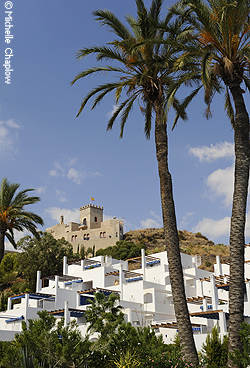HISTORY OF MOJÁCAR
Mojácar has a long, complex history that stretches over 4,000 years. Populated by Phoenicians, Carthaginians, Romans, Greeks, and Moors, it remains an intersection of many cultures. It was under Moorish rule that Mojácar really began to flourish. The castle was built and the town walls were expanded and fortified.
In 1488, King Fernando and Queen Isabel came to the area to demand the submission of its local leaders. All complied except for the Mayor of Mojácar. When later questioned about his absence from a meeting held near the town’s Fuente Mora, the Mayor reportedly stated that although he was a Muslim, generations of his people were Spanish by birth and deserved to be treated more “like brothers, not enemies…”. Evidently, Fernando and Isabel were sufficiently impressed with the reply to accept the Mayor’s pledge of loyalty and the town continued to flourish for the next four centuries.
 |
| From apartments to castles, Mojácar can provide the home of your dream. |
Mojacar’s fortunes, however, began to change around the middle of the nineteenth century when its population started to decline. The region (technically Europe’s only desert) began to suffer severely from droughts, forcing the emigration of many inhabitants. Some went northward to seek employment in the factories of Catalunya, while others emigrated further afield, including to the Americas. In fact, local legend claims that the cartoonist Walt Disney was born in the area and immigrated to the United States when he was a child.
This depopulation of Mojácar continued until the 1960s, when it reached critical levels, with just 1,000 residents remaining in the area. Local leaders decided to give away land to anyone who promised to build on it. This offer proved to be the spark which rekindled Mojácar’s economy. The town still has one of the highest expatriate populations in all of Spain. It was also at this time that the Indalo became the symbol of Mojácar. The prehistoric cave drawing found near Vélez Blanco represents a man holding a rainbow over his head. It is considered a lucky totem and can be found recreated on the fronts of homes and businesses throughout the province.